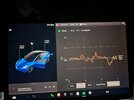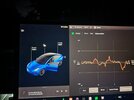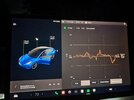Awesome discussion! Thanks so much for being willing to bounce ideas back and forth.
I hear what you're saying, and in theory... it should be what youre describing.
Thing is, I'm super OCD on the miles thing. I can assure you that once the BMS decides for example... 282 is full charge. 50 percent of that will always be 141.
The BMS makes its adjustments based on many things I'm sure. But it is directly related to the miles.
The BMS does "Coulomb counting", measuring charge in and out of the battery, simultaneously with voltage. That uses electronics that has some inaccuracy. But those numbers, plus open pack cell voltage (available only when in deep sleep) are the only physical observations available on board the car.
There is no direct physical meter for either the (a) actual current state of charge, or (b) the total energy capacity available. Those would require insight into atomic level condition of the battery cells available only in a laboratory and for (b) further dynamical experimentation. And yes everything changes with temperature as well.
Point being, when I arrived home it saw 141 and showed 50% SOC because that is exactly half of what it's expecting the total capacity to be.
Please keep following me here. Once it settled, it realizes it doesn't have 141 miles worth of energy available. It actually has 150 miles worth of energy available.
Instead to just stay at 50% SOC and allow the miles to change. It stays stuck on there can only be 141 at 50% SOC and increases that number instead.
Yes, there are two options for adjustment as you have understood correctly, but there's a reason it works as it does.
There are two uncertainties as mentioned above: current state of charge, and total full pack energy. The current state of charge is much more likely the one to develop inaccuracy in the short term and is what is adjusted. The estimate of the total full pack energy does eventually change with time, but that is an estimation period of weeks to months, so it takes a while for this to be adjusted, but eventually it will be.
The total pack full energy physically changes only very slowly---unless you have a catastrophic battery fault---so it's the state of charge estimate which is adjusted faster, and that is what you saw.
To get the full pack energy estimate adjusted you want the car to go into deep sleep at a wide variety of state of charge from 90% to 10%. At some point the algorithm decides upon a recalibration either up or down on full pack energy. It's unpredictable, slow, and no way to trigger it on your own but over time it is approximately right. Sometimes the full pack energy estimated will be below truth, sometimes above.
The algorithms for doing these are non-trivial and a product of years/decades of fundamental battery research science. In sum, the car is working correctly as designed, and there's a reason for it.





